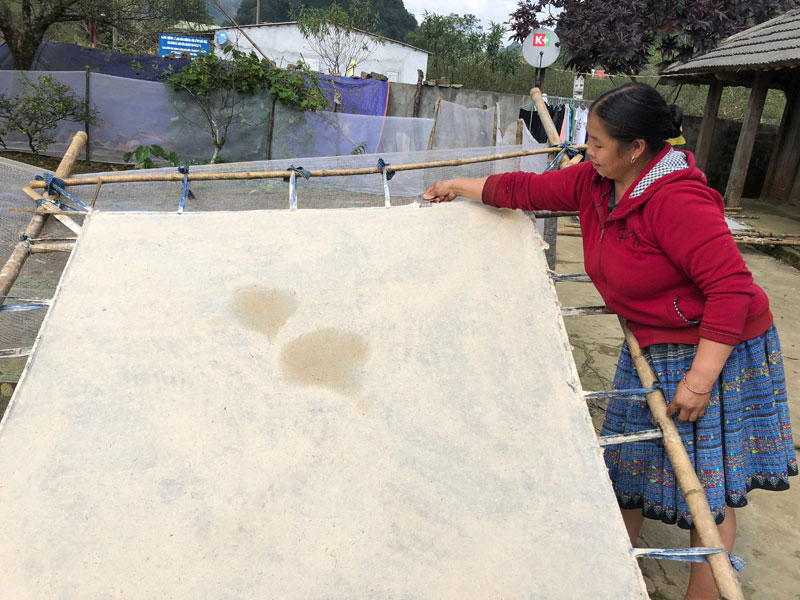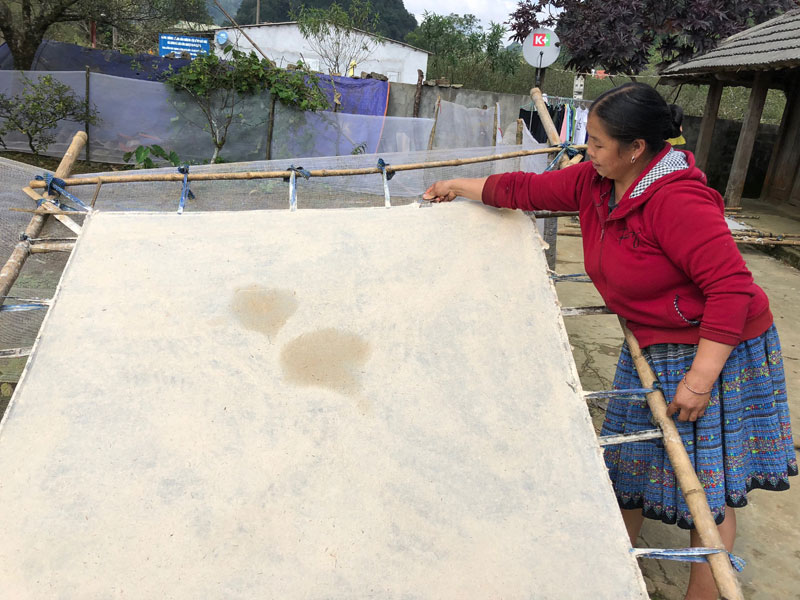


 The women of Mong ethnic people in Cha Day hamlet, Pa Co
commune (Mai Chau) are making Do paper (poonah paper).
The women of Mong ethnic people in Cha Day hamlet, Pa Co
commune (Mai Chau) are making Do paper (poonah paper).
Ms. Mua Y Mai in Cha Day hamlet, Pa Co commune says to make the Do paper from Aganonerion polymorphum, first look for the small young parts of the plant, peel off the hard shell, then mix them with the ash and put it in cooking pans. The cooking time is up to 3 days and 2 nights. To be more successful, they are put into the sacks, soaked in water for about 10 days and then picked out. The ash is washed off and then it is smashed into a kind of powder. The pulp is then mixed into clean water, and stirred until the powder dissolves. After that, the women prepare the paper molds stretched with mesh fabric. They use a large ladle to scoop up the liquid pulp to spread onto the cloth. The finished paper after drying under the sun and wind will be peeled and folded for use when having important family matters.
Besides, the linen weaving and beeswax painting of the women of Mong ethnic people are like an art. Ms. Sung Y Mua in Hang Kia hamlet, Hang Kia commune says that it is necessary to make the wax hot so that it can melt before drawing the patterns. It is important to keep the fire evenly when cooking so that the wax does not dry out. Therefore, the drawing person always sits next to the oven, putting a pen into a hot pan of wax and putting the hand in straight lines on the fabric. The process of drawing beeswax on fabric seems simple but takes a lot of effort and time. First of all, it is necessary to make linen and weave the cloth.
It takes from 6 – 7 meters of linen to make a dress of Mong ethnic people. And it takes 32 stages to make a linen sheet.
For Mong ethnic people in Hang Kia and Pa Co communes, Do paper is always associated with the spiritual life. According to Mr. Sung A Mang, the Chairman of the People's Committee of Pa Co commune, Do paper is often used in festivals, Tet holidays and for worship.
The amazing natural landscapes, the traditional cultural identities, the villages of Mong ethnic people in Hang Kia and Pa Co have created tourist attractions to domestic and foreign tourists coming to Mai Chau in recent years.
At the end of May, the Hoa Binh Provincial Ethnic Arts Troupe organized a series of performances for residents in Region 2 and Region 3 communes across the province. Bringing art to ethnic communities in remote, isolated, and especially disadvantaged areas has become a meaningful activity. These are not merely artistic performances but also journeys to disseminate cultural values, enrich spiritual life, and contribute to preserving the cultural identity of ethnic minorities.